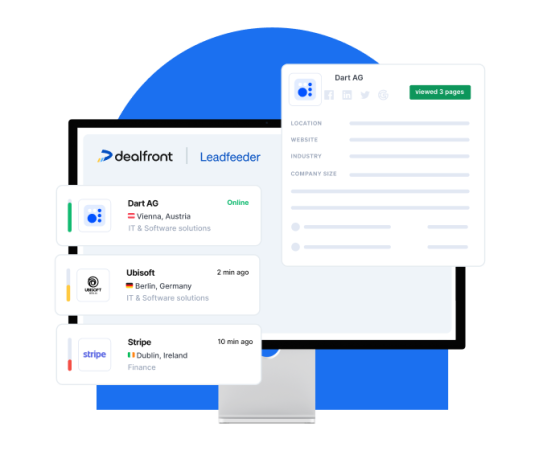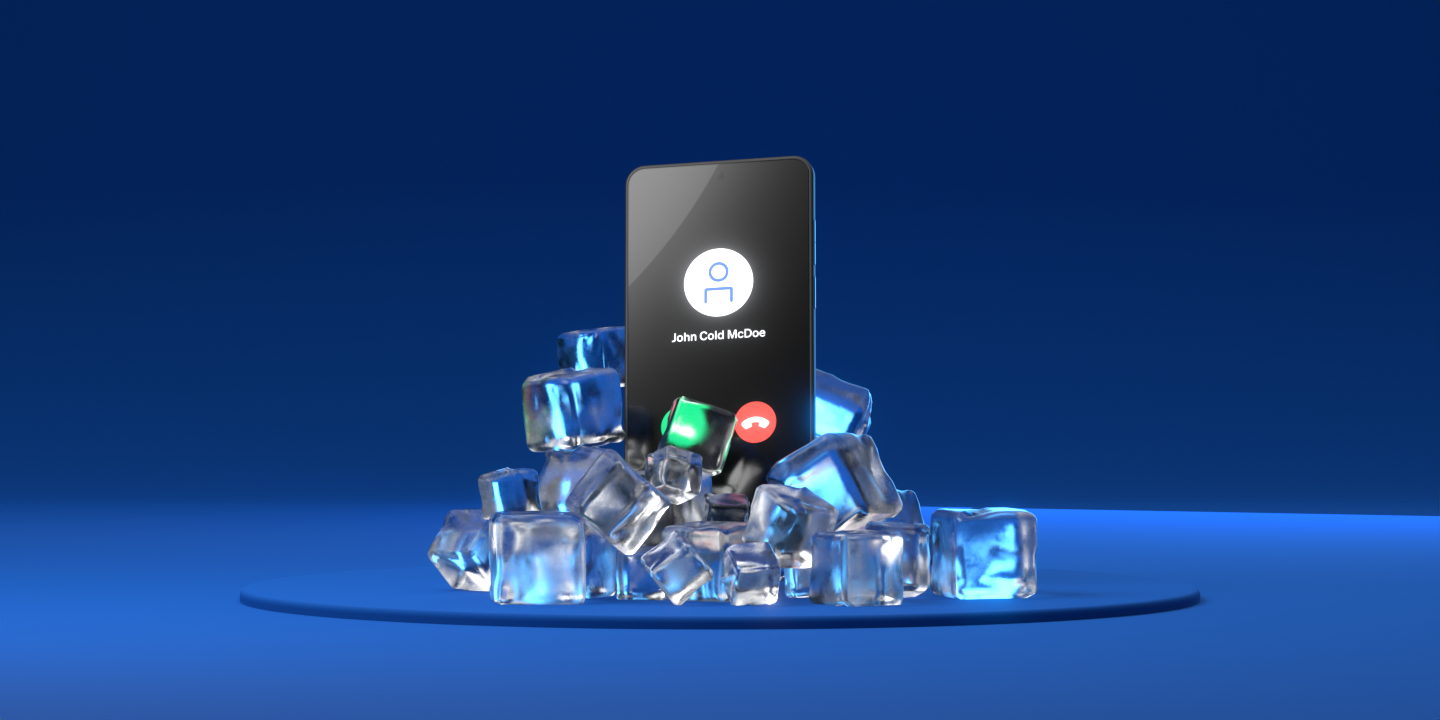Outbound sales is becoming more challenging if you don’t get it right. Today, inbound and PLG strategies are on the rise as more and more customers prefer exploring and purchasing products and services on their own terms.
If your company is looking to increase revenue through product-led growth: you need an inbound sales team.
In this post, our internal experts at Dealfront share some of their best practices for inbound sales and product-led growth. We’ll start with the basics of PLG and inbound sales, progressing to practical steps on how to build a PLG-driven inbound sales team.
We’re covering:
The difference between a traditional inbound sales team and a PLG-driven one.
What to take into consideration when hiring for an inbound sales team.
How to organize the structure of your inbound sales team.
Tips on what tools to implement for your inbound sales team.
Let's jump right into product-led growth and why it matters to your inbound sales team.
What is product-led growth?
Product-led growth (PLG) is a business model that uses the product itself as the primary driver for customer acquisition, retention, and expansion. It's a self-service approach where the customers get to learn and buy on their own terms.
PLG relies heavily on the product's value and user experience to close deals, while sales-led growth (SLG) is more dependent on 1:1 guidance from sales reps.
Word-of-mouth is also an important cornerstone of the PLG approach; if customers are pleased with the product, they’ll feel encouraged to share it with others through viral loops or referrals. A great example of this is Calendly. Their PLG approach helped them grow a community of loyal product advocates as their product basically sold itself as people used it.
Product-led growth is based on:
Free trial periods
Freemium versions
User-centric design
Self-serve onboarding
Viral loops or referrals
Customer feedback
A majority of B2B companies have already implemented a product-led motion.
But, a PLG strategy on its own is not always enough. A complete reliance on self-service and product value doesn't work for all companies. If you're a B2B tech company with a complex sales cycle, you might need to add some human engagement into the mix.
That's where the inbound sales team comes in.
Supporting your PLG strategy with a dedicated sales team will strengthen the financial results, helping you close, retain, and expand more B2B deals.
What is an inbound sales team?
An inbound sales team is responsible for engaging with and selling to prospects who have shown interest in the company's products or services. Inbound sales focus on channels like content marketing, SEO, paid ads, and social media.
Unlike an outbound sales team, where sales reps proactively reach out to potential customers, regardless of whether they've shown interest or not. Outbound sales rely on cold emails, cold calls, and commercials on TV, radio, and print.
Inbound sales is based on the inbound methodology – guiding potential customers through the different stages of the buyers' journey, also known as awareness, consideration, and decision.
The sales approach varies through the different stages, depending on how ready the prospect is to purchase.
For example, if a prospect is in the awareness stage, your inbound sales team can focus on offering links to relevant content. This helps build the relationship with the prospect. If the prospect is further along in the journey, the team will focus on addressing specific pain points and offering customized solutions.
Adding an inbound sales team is a great way to accelerate your B2B sales strategy, especially if your company is focusing on product-led growth.
A PLG-driven inbound sales team will help you:
Gain new customers at a much lower customer acquisition cost (CAC).
Build better relationships with your prospects and customers.
Get valuable user feedback to improve your product.
Traditional inbound sales teams vs PLG sales teams
At Dealfront, we have an inbound sales team, as well as an outbound. However, we call our inbound sales team the PLG team since their main focus is product-led growth.
Dealfront's Chief Revenue Officer, Kevin McIntyre, shared his thoughts on this:
"Our sales teams are structured to support the different channels of demand generation and customer acquisition based on the way they want to buy. We have a PLG sales team that augments and strengthens the PLG GTM motion. In our other channels of engagement, we have separate sales teams that orient themselves to optimizing that channel's needs."
What's the difference between a PLG sales team and a traditional inbound sales team?
A traditional inbound sales team is more of a response team focused on interested prospects. In contrast, a PLG sales team relies on the product itself to drive customer acquisition, retention, and expansion. The PLG team can still offer customer support and account management, but their primary goal is to improve the product's customer experience rather than directly selling it.
Another big difference is that the PLG sales team focuses on PQLs (product-qualified leads), and the traditional inbound sales team on SQLs (sales-qualified leads).
PQL: A PQL is a lead that has shown a high level of product engagement or usage, indicating a strong likelihood of becoming a customer.
SQL: An SQL, on the other hand, is a lead that has demonstrated a strong likelihood of becoming a customer based on criteria like interest, budget, and needs.
The PLG sales rep gets involved when a lead is converted to PQL, and the traditional inbound sales rep gets involved when a lead is converted to SQL. In other words, the concept is the same, but the criteria are different.
Fun fact: Only 25% of B2B SaaS companies report using PQLs. However, the conversion rate for free accounts is 3x higher when PQLs are used.
That was the basics – now, it's time to talk about how you can build a PLG-driven inbound sales team.
How to hire for an inbound sales team
Hiring the right people for your inbound sales team is an art and a science, you want to see both tangible results and a good attitude.
Two of our sales reps at Dealfront put together their thoughts on how they manage remote sales. Here are some of the qualities that they feel you should be looking for when hiring salespeople:
Be a self-starter: Look for people who have an open, creative mindset. Can they look at problems from several different angles and figure out out-of-the-box solutions?
Have an agile mind: What types of challenges have they faced in their career, and how did they overcome these?
Show accountability: Being accountable for their own actions, and also for the team as a whole, is an important part of sales leadership.
Learn continuously: Showing an eagerness to learn on a daily basis is crucial. You want salespeople who are staying up to date with industry insights continuously.
Be open to feedback: A great salesperson must be open to constructive feedback. Some companies provide this feedback casually in the office; others wait for a formal employee review.
Emphasize teamwork: Above all, working together as a strong inbound sales team can put your team on the path to success. Your team should move collectively toward higher financial rewards and industry recognition.
The right talent will push your team to a higher level – but where can you find them? Recruiting requires flexibility, effort, and, above all, diversification. If you're exclusively looking for talent in one place, you will only skim the surface of what's out there.
That's where our Director of Talent Acquisition, David McDonnell, takes the lead. He shared some of the sources he used to find exceptional talent for the Dealfront team.
His go-to tools include:
LinkedIn: direct sourcing via InMails using LinkedIn Recruiter
Xing (particularly in the German-speaking regions of Europe)
Networking events/career fairs
SaaS/tech sales forums
Advertising across multiple platforms
Referrals
Internally (referred to as internal mobility)
Social media advertising (particularly for junior or entry-level positions)
With these tools, David is able to find the best fit for our PLG sales team.
Now, let's get into how you can structure your sales team for ultimate success.
Organizational structure for a typical inbound sales team
Almost every company will have a unique sales team structure, and there's really no right or wrong. How you determine the structure is up to your own organizational culture and what works best for the individuals in your company.
To give you some inspiration, we will share how we structure the inbound (PLG) sales team at Dealfront.
CRO
At Dealfront, CRO Kevin McIntyre oversees revenue strategies. In this key role, Kevin ensures that the inbound sales team is deployed in the most effective way possible to lead the PLG motion.
He expands on that for us:
"For our PLG motion, we need enthusiastic sales and customer-facing professionals to support a product trial/experience and assist them in achieving their desired goals and ambitions. This is very different from traditional sales-led growth, where we might be proactive in targeting good-fit accounts to whom we feel we can bring value. Both sales motions are important, but there are different skills, different activities, and different expectations."
VP, growth, and RevOps
Before being promoted to Dealfront's Chief of Staff to the Revenue team, Carol Martindale was the VP of Growth & RevOps. In that role, she worked hard to make sure the team reported accurate demand-generation numbers, scenario forecasts, general status updates, and KPI trends.
Being data-driven, the team communicated regularly about what they’re seeing and how they can help drive decisions for demand generation and accurate forecasting methodologies.
Carol shared some thoughts on how she was involved with the PLG salespeople:
"In my previous role, my main focus was to make sure all processes are working accordingly. Using our data-driven approach, we are able to make changes to make the PLG approach better every step of the way."
Senior Director, RevOps
At Dealfront, our senior director of RevOps, Jaakko Paalanen works more on the ground with key revenue leaders and managers to ensure their teams have what they need, from a process and technology perspective, to support their revenue and growth goals.
In our structure, the senior director of RevOps reports directly to the VP of RevOps:
The senior director of RevOps has a team of RevOps managers, analysts, and CRM administrators to help support our four pillars of RevOps: data, insights, process, and system.
RevOps also closely collaborates with the enablement team to ensure our revenue teams have the training and resources they need.
Director, PLG
At a product-led growth company, the director of PLG plays an important role. One of the key aspects of the role is to create and communicate sales goals to the sales managers for their respective teams and propose ways to achieve those goals.
Some of the information that the VP of growth and RevOps might expect to be reported weekly includes annual recurring revenue (ARR) gained during the week (split by team) and how the overall team is pacing versus its monthly and quarterly targets.
Additionally, there will be a high-level overview of the rate at which deals are progressing, where they are in the various pipeline stages, and overall forecasting on weekly, monthly, and quarterly attainment.
Improving efficiency across the team is an important area for us so we can provide continued training for existing team members. Every individual brings something different to the table. It should be your goal to ensure team members are motivated, so the PLG Director should always be looking for ways to boost morale and retention. Work with sales managers to build efficient workflows, but don’t forget, it's not just about the procedure.
The person in this role needs to work closely with the product and marketing department to ensure that they have an active feedback loop and that we're operating and following up on inbound leads as effectively as possible.
PLG sales leaders (inbound)
At Dealfront, the PLG sales leaders work with a remote sales team. They have regular calls with the team, discuss deal reviews, and hold one-on-ones with team members and the boss.
In addition, PLG sales leaders handle hiring tasks, relay feedback to our product teams, assist with handovers to customer success teams, and make sure the sales flow is running smoothly.
PLG account executives
We're proud to have great PLG account executives with us at Dealfront. They handle a variety of tasks, like product demos, emails, trial training calls, ongoing assistance and follow-ups with our current trial base.
There are also ad hoc projects with customer service and marketing, pipeline management and forecasting, learning from and analyzing sales numbers and calls, and overall collaboration and idea sharing with the entire Dealfront business growth team.
Account executive Thijs Schutyser let us in on his insights:
"It's great to have smart conversations with our inbound/PLG customers. It's clear they've done their research, so our conversations get deep in a pretty short time frame. That's what makes those peer-to-peer conversations so cool. It's exciting to connect with our customers with like-minded interests to help them gain a high level of success."
His colleague, account executive Faustine Ollier added:
"We get to communicate with customers on a variety of different challenges, and every prospect, structure, process, and team is different from another. As an AE, I try to help them rethink their process and show them a different way to find and manage their opportunities. I try to build a good relationship with the prospect, to be the person to help them with a challenge, not just be the salesperson on the line."
Now, the next step is critical to the success of the inbound sales operation: Finding the right tool stack.
Tool recommendations for inbound sales teams
Whether your sales teams are scattered remotely or working from an HQ office, they should all have equal access to tools that can help them retain, close, and expand deals.
Here's a snapshot of the automation tools we use to keep our sales reps focused and organized:
Sales intelligence: Pipedrive, Intercom, Google Analytics, Dealfront
Sales enablement tools: Intercom, Highspot
Sales engagement: SalesLoft
Communication: Slack, Mailchimp, Zoom, Calendly, Loom
Sales pipeline, analytics, measurement: Dealfront, Salesforce
Customer relationship management: Salesforce
What about your organization? Does your technology sync and support the type of analytics you need for accurate forecasting? Make sure you have the right tools, integrations, data, people, and communication channels in place to support the process.
Your tools should help provide a solid ROI from your sales efforts.
Your inbound sales team: The key to PLG growth
With all of that said, putting together an inbound sales team that can successfully execute your vision and goals takes planning. Now that you've had the chance to take a peek behind the scenes here at Dealfront, you can use the insights to figure out what works best for you, your team, and your business.
Now, we can’t dish out advice on PLG growth and inbound sales without sharing our free trial with you. B2B companies like yours use Dealfront to stop wasting resources on leads that don't convert. The platform will help you identify companies that visit your website, track on-site activity, and reach out to qualified leads who are ready to buy.




